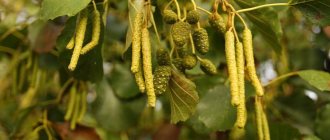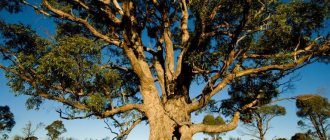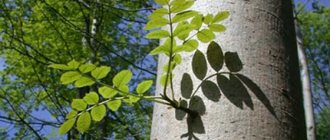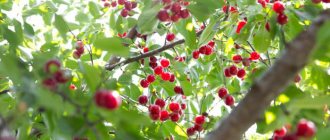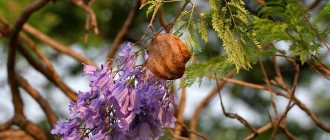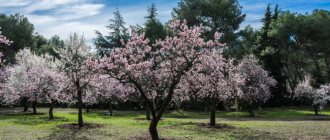Dwarf willow - the smallest tree in the world
This variety has many subspecies, and the main part has chosen a rather harsh habitat. You can find such a willow outside the Arctic Circle; it also loves highlands. Even the Alpine cold is not scary for her. Scientists have repeatedly discovered a tree at an altitude of over 3000 meters.
In the United States, dwarf willow can be found in most states. All members of the family love wet places, so they grow mainly along the coastline. They are not afraid of the presence of surf, and the beauty of the smallest trees is so loved by many gardeners that landscape designers noticed them. Now dwarf willows are used to create miniature hedges and decorate rock gardens. The main advantage of the tree over others is its resistance to frost. Even a thick layer of snow will not lead to freezing.
The tree can be found not only in wet areas. He is able to grow on a rocky slope, among cracks in rocks, and he really likes limestone. Excessively acidic or salty soils are not a problem at all.
Purple willow Gracilis (Salix purpurea Gracilis)
The small graceful purple willow Gracilis, with a height of 50 to 150 cm, is ideal for creating hedges; it also fits well into the composition of flower beds, focusing attention on itself, and is also suitable for creating various geometric shapes in the garden.
Numerous thin shoots and small narrow leaves of silver-green color form an aerial crown in the shape of a ball. From a distance, the willow resembles a bluish cloud. The shrub blooms before the leaves bloom with large bright purple catkins.
Purple willow Gracilis is easy to care for, unpretentious and drought-resistant. However, it develops better in moist and fertile soils. The plant is light-loving, so it needs to be planted in open space. Its highly developed root system strengthens the soil.
To obtain a dense crown of the desired shape, it is recommended to trim the bush regularly.
Distinctive features of the species
The vegetation process among representatives of the species varies depending on the climatic zone. Alpine dwarf willows open their buds by April; the growing season in other subspecies begins later. The main external distinguishing features were the young shoots, as well as the size of the trunk. For example, a small tree growing in the northern Urals exhibits shoots 25 centimeters long.
Its Khibiny relative is called globular willow. It does not have such long shoots, and its counterparts from the Alps are completely tiny. For protection, they need down, which is located at the very stem of the leaf, and it lasts quite a long time. A common feature of all the small trees of this family is very poor growth. Representatives of the northern Urals have the highest degree of adaptation. They need only 3 years to reach the same size as their Khibiny counterparts, which takes them 11 years. Dwarf willow is a pest-resistant tree. She doesn’t even care about lack of food, so she can be called one of the most unpretentious.
Boyd's Willow (Salix Boydii)
Among the willows there are both tall trees and shrubs creeping along the ground. Boyd's willow, which grows only 50 cm in height, is also a dwarf species. It is very reminiscent of a bonsai. Such a plant will look perfect in a rock garden or on an alpine hill.
Boyd's willow grows very slowly (5-7 cm per year), independently forming a bizarre crown. The tree has small fluffy rounded leaves and an uneven trunk. Willow will go well with creeping conifers and flowering perennials.
Boyd's willow, like all representatives of its species, loves to grow in the sun. It is unpretentious, winter-hardy, but susceptible to diseases and pests. Can get rust and be attacked by willow scale insects.
How important is the world's smallest tree for nature?
Some of the most common places for dwarf willow are:
- areas covered with moss;
- rocks;
- priming.
Each tree strives to grow as close to its relatives as possible. This mechanism, designed by nature, helps them stay warm by retaining heat. The smallest tree in the world has a rather simple but important role. It is eaten by insects, birds, and animals. Thanks to its ability to recover, the tree quickly grows again, so there is always enough of it. It serves as protection for insects from the winds; birds use the stems to build nests.
Iva Matsuda (Salix Matsudana)
The Matsuda willow, which is significantly different from all members of the family, looks good both in summer and in winter. It has an openwork weeping crown with curved yellow-red shoots. Therefore, this willow is also called twisting willow.
In nature, Matsuda willow is found along the banks of rivers and reservoirs in Japan, Mongolia, China and Korea. Under favorable conditions, it can grow over 10 m, half of which is occupied by its crown. Young shoots are yellow or olive in color, which darkens over time.
Willow leaves are long, elongated, green on top and whitish below. After blooming, they are covered with small villi and then become smooth. Yellowish inflorescences-earrings bloom simultaneously with the foliage.
The plant is undemanding to soil, moisture-loving, but does not have good winter hardiness. Matsuda's willow is good in both group and single plantings. In winter, its bright branches without foliage will add color to the “white silence” on the site.
How do people use dwarf willow?
The Japanese love dwarf trees because they can be grown in an ordinary flower pot. However, the cultivation procedure is very complicated.
You will have to spend a lot of time and put in a lot of effort. The process involves following the “hilling” technology. The tree needs to cut its roots, form a crown, create depleted soil, limit watering, and create the most cramped conditions possible. You will have to constantly care for the willow:
- it is necessary to prune old branches;
- pinch out new cuttings;
- carefully cut off excess shoots;
- use other bonsai techniques.
Such treatment becomes a real test for the dwarf willow. However, the cost of one copy can be fabulous. Only a few manage to achieve a high level of skill, so the work of masters is highly valued.
Reproduction and transplantation
Dwarf varieties can be propagated in two ways:
Cuttings must be rooted before planting. In other words, sprout roots on them. This can be done simply by placing the cutting in water or wet sand. After two weeks, the roots can be planted in separate soil. It is better to make cuttings from young shoots; old and woody shoots will take much longer to germinate.
If you don’t have many mature shrubs, you can resort to seed propagation. It is recommended to sow the material immediately after ripening. A prerequisite for successful germination is a temperature regime of 26-26°C, no less.
In order for the dwarf willow to retain its decorative properties, it will require feeding (2-3 times a season). Watering once every three days is required, especially in hot summers.
Dwarf species of willows are just a godsend for landscape designers. Small willows make a wonderful addition to the garden. Look great near ponds and reservoirs. Landscaping the area with dwarf willows is an excellent solution. Today, dwarf willows are so popular that many botanical specialists are working on the selection and development of new varieties.
What types of dwarf willows are there?
In fact, the world's smallest tree has more than a dozen varieties. Many botanists argue about the classification of trees. For example, in addition to the smallest one (herbaceous), there is a creeping one. This is a frost-resistant plant that prefers treeless tundra and areas where arctic cold reigns. The shrub is characterized by long branches, each of which can reach one and a half meters. It has no side shoots. Such a willow can reach a height of more than 30 centimeters. It survives cold and wet well, is unpretentious in care and takes root in poor soils. A characteristic feature of creeping willow is poor reproduction. For several years it can root one branch, and gardeners note that even good pressure does not help. Even in many cases, a successful cutting technique does not bring the desired result. To grow such a shrub, it is better to cut the cuttings before the leaves open.
Alpine and rock willows are very beautiful. The first is distinguished by small leaves and dense branches. Rocky has larger leaves and sparse branches that grow chaotically. Gray leaves look extremely interesting, adding variety to the color scheme of the usual garden.
Shaggy willow is distinguished by beautiful earrings that have a golden yellow hue. Moreover, they are quite long, can reach 7 centimeters. It has a late flowering period; the small tree begins to bloom flowers only in June. The leaf shape is round. They are painted green. To retain moisture that falls during rains, the tree has acquired hairs. The most common shaggy willow is in Yamal. Sometimes you can meet her in Murmansk. She is not afraid of either frosts or poor soils. However, the shrub must be protected from drying out.
Hairy willow leaves turn yellow between October and November. This is an amazing species of dwarf tree because it can grow up to 3 meters. However, most grow only 50 centimeters in height. There is a clear pattern here: small trees grow successfully, despite harsh climatic conditions, but become squat. This is why their smallest representative can truly be considered tiny, because it has to grow where most plants cannot survive. Shaggy willow, like herbaceous willow, can grow successfully in a pot. It is perfect for all gardeners who love oriental themes.
Opposite-leaved willow is a native of Korea. It also grows on the territory of the Japanese islands. Feels good in Russian winter conditions. She especially likes to rest under the snow. The shrub is characterized by long, green-gray leaves. It needs special care, but pleases the eye with the rounded shape of the leaves, representing the most delicate miracle. Even without regular trimming, the plant begins to turn into a very bizarre creation.
Another representative of dwarf willows is spear-shaped. It usually has a height of 50 centimeters, but sometimes grows up to 2 meters. It requires mountain conditions; the tree does not like waterlogging and prefers the tundra and forest-tundra zones.
Decorative willows in my garden are the five best varieties.
In recent years, willow has returned to the Moscow Gardens. At one time, they were sent into “exile” outside the site, although this tree can become not only a stylish garden decoration, but also a home doctor and a supplier of materials for handmade products.
One of the important advantages of willow is its very high growth rate.
The variety of species and varieties of willows is so great that each of you can find your own plant to your liking. Just two years ago I planted the first willows in my garden. And I want to talk about them.
1. Willow in Memory of Mindovsky :
- a tree with an openwork, broadly oval crown up to 7 meters in height, crown diameter up to 6 meters with strongly weeping branches hanging to the ground. The shoots are thin, flexible, very long, light golden-olive in color. This is a willow of the Ural selection. This means that frost resistance is very high. And so does the growth rate. This year, from these seedlings (autumn 2016), the weeping willow grew almost three meters.
2. Willow Ledebura.
A wide, low tree or shrub with an openwork rounded semi-weeping crown. The lower branches grow upward at an almost acute angle, the bush itself is highly branched, its diameter is almost equal to its height - about 4 m. The shoots are thin, flexible, long, light gray. The leaves are medium-sized, narrow, greenish-silver.
3. Purple willow Nana.
This variety of willow bush is a lifesaver, as it will easily fit into any garden. An elegant, openwork ball with a diameter of up to 1.5 - 2 m with purple thin and flexible shoots. It cuts well, you can give it the shape of a perfect ball. Its leaves are narrow, pale green above, bluish below, turning golden yellow in autumn. This willow grows very quickly, and is also winter-hardy. Loves sun and moisture.
4. Iva Hakuro Nishiki.
It is loved by many gardeners for its delicate, exquisite coloring of the leaves. When they bloom in spring they are salmon pink, later turning white and green. This shrub is up to two meters high and quite spreading. Most often, gardeners grow it as a standard tree or shape it into a ball and maintain it with regular trimming. It grows quickly and practically does not get sick. Of all the willows, this “Japanese” one prefers fertile soil the most.
5. But with willow Erythroflexuosa
That spring I had to say goodbye. This South Asian miracle could not withstand our frosts. And after two winterings it emerged not with an increase, but with a significant decrease in the crown. Although there was a highlight in it: serpentine-curved, orange-red shoots, gracefully hanging, really, really good.
In order not to change my favorite number “five” this September, instead of the twisted sissy Erythroflexuosa, which was removed from the garden with great regret, I planted rosemary willow . Its spreading crown with numerous thin and upward-pointing branches gives the impression of a fountain. The leaves are dark green on top, with a bluish underside. Moreover, this variety sheds its leaves much later than other varieties, which makes it more decorative. Alas, the downside of this variety is that it grows rather slowly.
Whatever variety of willow you choose for your garden, I am sure that these elegant and so diverse beauties will add peace, tranquility and beauty to your garden.
Why is it worth planting an ornamental willow in the garden?
Garden fashion does not stand still, and yesterday’s superstitions and prejudices regarding this or that plant for the garden are becoming a thing of the past, and the former garden “outcast” is becoming popular. At one time, the willow tree was sent into “exile” outside the site. Despite the fact that this tree has many advantages.
1. Unpretentiousness. Willow is undemanding to care and grows well in acidic, moist soils.
2. Variety of species . There are more than 300 types of willow and among them you will definitely be able to find something to your liking. For the Moscow region, I advise you to pay attention to the Sverdlovsk weeping willows: In Memory of Mindovsky, Waterfall, Tent, Weeping Gnome, Ideal - these are examples of perseverance.
3. Willow is useful for household needs - its flexible rods are well suited for weaving baskets and fences. For those who have their own farm, willow leaves are good food for rabbits and goats, they love them very much. This tree can often be seen on beekeepers’ plots, since willow is a recognized spring honey plant.
4. Willow has high antibacterial properties, as it contains acetylsalicylic acid (plant salicin). To this day, willow bark and leaves are used for medicinal purposes.
Of course, there are also disadvantages to beautiful willows.
1. Strong and rapid growth . Already 3-4 years after planting, you need to take a pruner or lopper (preferably in the spring) and remove the shoots and lower branches on the trunk. If you don’t do this, you can end up with a neglected tree that shades everything around.
2. Willows, in particular white willow varieties, are often affected by aphids, which can easily spread to other plants and fruit trees. Therefore, you need to regularly inspect willow trees and, preferably, plant willows away from apple trees, words and currants with gooseberries.
3. In almost all cultures, willow is considered a “female” tree, a symbol of endless life and tenderness. Willow is considered a tree that primarily absorbs everything negative. But be careful: when the supply of negative energy runs out, the willow may begin to draw out positive energy, and the person will feel devastated. The solution is the same - do not plant willow near housing.
Willow growing in the right place is a source of peace , helping to more easily endure grief, extinguish outbursts of anger and restore the ability to reason soberly. Another feature of this tree is the preservation of peace and harmony in the family.
Without a doubt, willow is quite worthy of decorating your garden , but whether you need to pay attention to beliefs is up to you. But do not doubt that the willow will thank you for your love and care.
Share link:
Alternative options for the smallest tree in the world
Among the smallest trees in the world, not only the herbaceous willow can be an excellent option for creating a rock garden. An ideal replacement would be small-fruited zhostere. The plant is characterized by miniature forms and thick trunks that have a twisted appearance. Zhoster really suits light stones, on which he creates a contrast effect. The flowering period is characterized by the appearance of round fruits. The plant itself is inconspicuous and even invisible. However, the zhoster complements the others well. Reproduction occurs using seeds that require stratification. Like willows, zhostere is resistant to cold weather. It needs to constantly receive sunlight and grow in normal humidity. Limestone soils will be quite suitable.
Among the smallest trees in the world, the small-leaved elm stands out spectacularly. His Frosty and Hokkaido varieties are great, but are susceptible to many diseases. They freeze out during winter and have difficulty reproducing. Things are even worse for the Geisha variety, but this elm more than compensates for its whimsicality with its spectacular appearance. Biloba ginkgo is suitable for planting on a hill. Recommended for landing at low altitude. In winter it should be covered with snow, in spring it is necessary to prune it.
Finally, attention can be paid to rhododendron. Of all the existing ones, the smallest in the whole world is the attractive rhododendron. All representatives can grow up to 80 centimeters, but the attractive rhododendron rarely exceeds 30 centimeters. Flowering occurs in May. A special feature of rhododendron is its interesting color palette. It can be light lilac and even bright purple. The flowers are characterized by neatness, the bushes have a delightful dark green hue. Rhododendron prefers to grow on rocky soil and loves moisture and cool air. It tolerates group planting quite well.
Stiff-haired rhododendron is also suitable for rock gardens. Its characteristic feature is the so-called cushions, and the plant can grow up to 40 centimeters in height. It maintains rich, dark green foliage year-round, preferring to remain in the shade. From time to time the bush needs to receive sunlight, then it will grow more abundantly. The coarse-haired rhododendron, nicknamed the alpine rose, is unpretentious to soil conditions. Among the smallest trees in the world, the Caucasian rhododendron is considered the oldest. It is characterized by squatness, dense branches, and blooms in May. Beautiful white flowers are pleasing to the eye, but if there is a warm, prolonged autumn, then in the spring flowering will occur slowly. The Yakushiman variety, which was brought about 100 years ago from Japan, is very popular. But this variety can no longer be called dwarf, because it can grow up to 1 meter.
Nature gives us various miracles. Small, almost tiny trees, finding their refuge among the harshest conditions of the world, have become clear proof of this and at the same time a real treasure of nature.
Rosemary willow (Salix Rosmarinifolia)
Rosemary willow, or Siberian willow, grows almost throughout Europe, Siberia, Primorye and northern Central Asia. The shrub with a lush crown reaches two meters in height, and grows even more in width, although rather slowly.
It has pubescent dark green leaves (silver on the back) that turn yellow in the fall, and rich red-brown shoots with a purple or violet tint. Numerous yellow catkins bloom before the leaves appear or simultaneously with them; bees are especially fond of their delicate floral aroma.
Rosemary willow is undemanding to the soil and requires virtually no care other than regular pruning to form a crown. The plant is light-loving, prefers damp places, and is not afraid of low temperatures.
A hedge created from rosemary willow will serve you for at least 20 years without renewal.
Willow or willow?
One day, on the eve of Palm Sunday, I heard two people arguing about the name of the willow . One of them claimed that it was a willow tree. Another called the bush a willow. Both were right, because... holly willow and willow willow and break off branches before the holiday.
Holly-leaved willow (red willow, red willow, red willow) is one of the earliest flowering species in central Russia. It is a tall shrub or tree with reddish-brown smooth branches. Flowering begins before the long narrow leaves appear. Large buds with red-brown scales are visible already in autumn.
Various furniture and boxes are woven from thin willow branches, rather than baskets, because... It is not worth storing food in them because of the bitter bark.
The willow is also called willow. This common plant can grow as a shrub or tree. The long leaves are wider than those of Norway willow. This type of willow does not tolerate prolonged stagnation of water.
Wolf willow allows you to quickly grow a hedge from cuttings stuck into the ground, which quickly take root. They need to be regularly trimmed or young flexible shoots intertwined with each other. An interesting variety is “Aglaya” with large silver earrings and red branches. The early flowering variety "Praecox" has earrings about 9 cm long.
Rules for planting and care
Caring for decorative weeping willow is easy. The only thing worth paying attention to is the composition of the soil and its moisture content. Under natural conditions, the tree grows on sandy or loamy soils and constantly receives the required amount of water from the reservoir. If you plant a willow far from natural sources of moisture (a pond or river), it will have to be constantly watered. On dry, hot summer days it will be useful to spray the leaves.
The plant does not need additional feeding. It adapts well to temperature changes and tolerates both heat and frost. However, you can periodically fertilize the soil with organic fertilizers - humus or compost.
It is most comfortable for weeping willow to grow on constantly moist soil. It will grow faster if the groundwater level in the area is high.
Willow propagation
Under natural conditions, the tree propagates by seeds; at home, cuttings or seedlings are used. Cuttings are harvested in spring or autumn; the middle sections of young branches that are no more than 2 years old are suitable for them. Next, they need to be prepared for planting:
- the optimal cutting length is from 20 to 30 cm;
- planted in the ground in a greenhouse or any other warm room;
- until the seedlings get stronger and are ready for transplanting, they need to be watered frequently, fertilized and the soil around them loosened;
- young trees are not planted outside in the first year; they must spend the first winter in a warm place.
Weeping willow is planted in open ground in the spring, when the snow has completely melted. By this time, the young tree should already have a fully formed root system. You can also plant it in the fall, when the period of sap movement has already ended. In this case, the soil will need to be covered with leaves or straw, and the tree itself with spruce branches.
If the seedling is tall and unstable, it will need additional support. A peg is placed next to it, and the young tree is loosely fixed with a rope.
Growing on a trunk
A weeping willow on a trunk will decorate any garden. Stamped trees are those in which a decorative crown, either its own or grafted, extends from a straight trunk without branches (the trunk itself). For these purposes, a variety such as goat willow is suitable. It can be grafted onto a standard, but there is another way to grow it original:
- after planting, choose a strong and powerful shoot and firmly fix it to the support;
- as it grows, the trunk is tied higher so that it grows straight and does not branch;
- In summer, side shoots need to be shortened by a third so that nutrients flow into the main trunk and it grows stronger;
- in the fall, the remaining parts of the shoots are completely removed, leaving stumps 0.5 cm long.
Read also: Orchid aerial roots, and what to do with them
When the stem reaches the desired height, the support is removed. The next step is to form a uniform, thick crown that will fall down. To do this, it is enough to trim it in such a way that all the branches grow downwards. Their ends are pinched off, and the shoots begin to produce new branches.
Weeping willow in landscape design - video
Globular
The globular willow grows up to 20 meters and has many massive branches. In winter, the foliage of this plant changes its green color to olive. The plant is attached to moisture, so it is found near the coast and dams. Resistant to cold. The leaves are elongated and slightly rough. To keep the willow spherical, it should be trimmed frequently. The globular willow grows in almost all parts of the country, but is observed even in Australia, Africa and America. This tree lives up to 80 years.
It should be planted in April. Seedlings are usually purchased from a nursery. When planting a willow tree, they dig a hole 30 centimeters deep and place seedlings there with fed soil in the form of peat and fertilizers. This will allow the plant to grow strong and healthy. The main thing is not to forget to water the seedlings regularly.
Landscape design with willow globulus
Due to its beauty and unusual appearance, globular willow is very popular in parks and gardens in our country. Even by planting only this decorative species, you can create very original compositions and entire gardens. Such trees lend themselves well to topiary and are traditionally used in single or group plantings and as hedges.
Protect from diseases and pests
Spherical species are susceptible to attacks by pests that can destroy an adult tree:
Larvae developing in the bark can damage the growth zone and destroy the tree.
Signs: loss of leaves, drying out.
Fight: removing damaged areas
Destructive for young branches.
Signs: a colony of larvae settles on young branches and oppresses them.
Fight: spraying twice with a kerosene-soap solution is required - 200 ml of kerosene and 50 g of green soap per 7 liters of water
Signs: egg laying destroys the bark, branches dry out.
Fight: lubricating cracks with tar (garden pitch, glue), bait traps for bugs
Signs: blackening of foliage and bare branches.
Fight: catching
Dangerous diseases of willow plants : fungus - heart rot, brown spot, willow scab, powdery mildew, bark necrosis, rust.
The photo shows willow scab. All fungal diseases are eliminated by spraying with fungicides
Plant or shrub: ongoing debate among scientists
For a long time now, scientists have been arguing about what the herbaceous willow is – a tree or a shrub. It can be noted that these disputes are not at all meaningless. And all because the characteristics of willow do not quite fit into the classical description of a tree. From standard terminology it is known that it must have a woody outer layer, a central trunk growing upward, a thickness in a mature specimen at the level of the human chest of 7.62 centimeters, and also have a multi-year development cycle.
Based on the descriptions listed, it is clear that the herbaceous willow can really hardly be called a tree. However, it has been proven that the plant belongs to the willow family. In addition, this smallest tree in the world has female and male earrings (the former are red, and the latter are yellow). Therefore, the plant can quite justifiably be classified as tree-like, despite its tiny size and the absence of some signs of a tree.
The creation of a Malaysian artist
It is impossible to ignore the smallest tree in the world, which was created by the Malaysian artist Kua Thi Tiongu, who used jelti and water jasmine to create a small tree for bonsai, which consists of growing dwarf trees. For over two years, the master grew the plant, which eventually reached only 12 millimeters. He was offered a lot of money for such a tree, but he refuses to sell his creation. And now he set himself the goal of producing a plant that would look like a tree, but in the shape of a shell or an animal.
